 Too bad that we've not had time to see Ian Curtis's kerbside gravestone, or the house in which he lived in Macclesfield, Cheshire: to compensate, I leave a scan from the cover of Joy Division's album Closer. But if you're on your way to leave your car near Manchester airport before leaving for Atlanta, Georgia, and have a few hours to spare, what better way to spend them than in peaceful Knutsford?
Too bad that we've not had time to see Ian Curtis's kerbside gravestone, or the house in which he lived in Macclesfield, Cheshire: to compensate, I leave a scan from the cover of Joy Division's album Closer. But if you're on your way to leave your car near Manchester airport before leaving for Atlanta, Georgia, and have a few hours to spare, what better way to spend them than in peaceful Knutsford? Knutsford is eager to display its strong associations with Elizabeth (Cleghorn) Gaskell (née Stevenson), and many people associate the town with her novel Cranford (1853), of course. The 'Hollingford' of Wives and Daughters (1866) also takes Knutsford as its model, although she is perhaps better known for her 'Condition of England' novels, Mary Barton (1848) and North and South (1855).
Knutsford is eager to display its strong associations with Elizabeth (Cleghorn) Gaskell (née Stevenson), and many people associate the town with her novel Cranford (1853), of course. The 'Hollingford' of Wives and Daughters (1866) also takes Knutsford as its model, although she is perhaps better known for her 'Condition of England' novels, Mary Barton (1848) and North and South (1855).

 Although born in Cheyne Walk, Chelsea, London, as a 12-month-old motherless child, Elizabeth Stevenson was taken into the care of her maternal aunt, Hannah Lumb, who lived in the house Heathwaite, in Knutsford. She spent her childhood and early youth there.
Although born in Cheyne Walk, Chelsea, London, as a 12-month-old motherless child, Elizabeth Stevenson was taken into the care of her maternal aunt, Hannah Lumb, who lived in the house Heathwaite, in Knutsford. She spent her childhood and early youth there.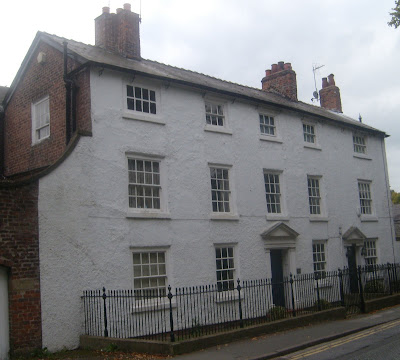
 Heath House, also on what is now called Gaskell Avenue, is where the highwayman Edward Higgins, who is represented in Gaskell's short story 'The Squire's Tale', and Thomas de Quincey's 'Highwayman'.
Heath House, also on what is now called Gaskell Avenue, is where the highwayman Edward Higgins, who is represented in Gaskell's short story 'The Squire's Tale', and Thomas de Quincey's 'Highwayman'. The parish church, Knutsford, where Elizabeth Stevenson married the Rev. William Gaskell in 1832. They were both Unitarians, however, and William was a minister at the Cross Street Chapel in Manchester, where they went to live.
The parish church, Knutsford, where Elizabeth Stevenson married the Rev. William Gaskell in 1832. They were both Unitarians, however, and William was a minister at the Cross Street Chapel in Manchester, where they went to live. The Royal George Hotel in Kings Street in the centre of Knutsford, and was visited by Elizabeth Gaskell.
The Royal George Hotel in Kings Street in the centre of Knutsford, and was visited by Elizabeth Gaskell. While I was photographing this tower, a woman on a bicycle dismounted, parked her vehicle and proceeded to tell me all about the Gaskell Memorial Tower and its 'mastermind', Richard Harding Watt. Leaving her bicycle freely leaning against some railings – Knutsford appears to be the kind of place you can do that without worry – she led me across the road to an interpretation panel and spoke more about Watt. I consider myself very lucky to have had this encounter, as she was Joan Leach, a noted local historian and the Secretary of The Gaskell Society. Many thanks for this, Joan!
While I was photographing this tower, a woman on a bicycle dismounted, parked her vehicle and proceeded to tell me all about the Gaskell Memorial Tower and its 'mastermind', Richard Harding Watt. Leaving her bicycle freely leaning against some railings – Knutsford appears to be the kind of place you can do that without worry – she led me across the road to an interpretation panel and spoke more about Watt. I consider myself very lucky to have had this encounter, as she was Joan Leach, a noted local historian and the Secretary of The Gaskell Society. Many thanks for this, Joan!
 The side of the tower shows a plaque of Gaskell, with her novels listed above, although – as was pointed out to me by Joan Leach – most of the titles are now obscured by ivy.
The side of the tower shows a plaque of Gaskell, with her novels listed above, although – as was pointed out to me by Joan Leach – most of the titles are now obscured by ivy.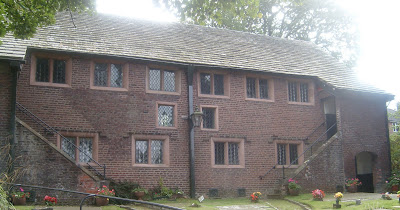
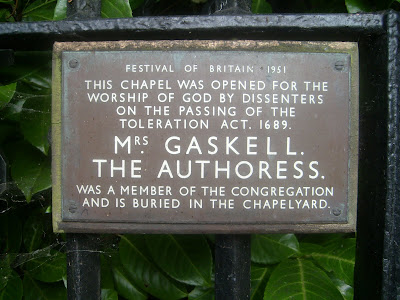
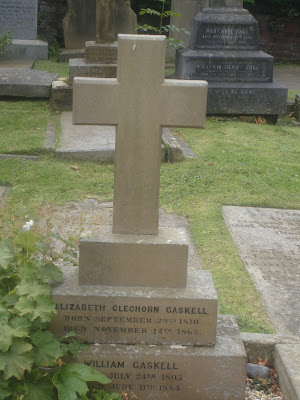 Elizabeth Gaskell is buried in the small cemetery in the grounds of Brook Street Unitarian Chapel, Knutsford. Her husband William Gaskell (1805–84) joined her almost twenty years later.
Elizabeth Gaskell is buried in the small cemetery in the grounds of Brook Street Unitarian Chapel, Knutsford. Her husband William Gaskell (1805–84) joined her almost twenty years later.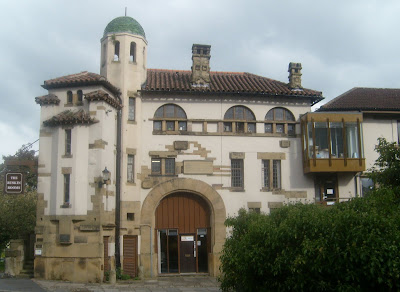 Richard Harding Watt, a great admirer of John Ruskin, named these rooms after him. An interpretation panel records that the architectural assistant resigned following arguments over the chimneys.
Richard Harding Watt, a great admirer of John Ruskin, named these rooms after him. An interpretation panel records that the architectural assistant resigned following arguments over the chimneys.
 'Let every dawn of morning be to you as the beginning of life, and every setting sun be to you as its close', from Ruskin's Lectures on Art (1870).
'Let every dawn of morning be to you as the beginning of life, and every setting sun be to you as its close', from Ruskin's Lectures on Art (1870).
 'Ruskin Rooms. This building was erected by Richard Harding Watt in his usual Mediterranean style in 1902 as a recreation and reading room for the townspeople. The architect was Walter Aston. Among the various uses to which the building has been put is a fire station and as the headquarters of the British Legion. It was substantially renovated in 1977.'
'Ruskin Rooms. This building was erected by Richard Harding Watt in his usual Mediterranean style in 1902 as a recreation and reading room for the townspeople. The architect was Walter Aston. Among the various uses to which the building has been put is a fire station and as the headquarters of the British Legion. It was substantially renovated in 1977.'For much more information on Elizabeth Gaskell, see The Gaskell Society website and Virtual Knutsford.



No comments:
Post a Comment